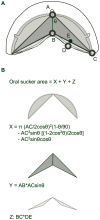Evolutionary novelty versus exaptation: oral kinematics in feeding versus climbing in the waterfall-climbing Hawaiian Goby Sicyopterus stimpsoni
- PMID: 23308184
- PMCID: PMC3537660
- DOI: 10.1371/journal.pone.0053274
Evolutionary novelty versus exaptation: oral kinematics in feeding versus climbing in the waterfall-climbing Hawaiian Goby Sicyopterus stimpsoni
Abstract
Species exposed to extreme environments often exhibit distinctive traits that help meet the demands of such habitats. Such traits could evolve independently, but under intense selective pressures of extreme environments some existing structures or behaviors might be coopted to meet specialized demands, evolving via the process of exaptation. We evaluated the potential for exaptation to have operated in the evolution of novel behaviors of the waterfall-climbing gobiid fish genus Sicyopterus. These fish use an "inching" behavior to climb waterfalls, in which an oral sucker is cyclically protruded and attached to the climbing surface. They also exhibit a distinctive feeding behavior, in which the premaxilla is cyclically protruded to scrape diatoms from the substrate. Given the similarity of these patterns, we hypothesized that one might have been coopted from the other. To evaluate this, we filmed climbing and feeding in Sicyopterus stimpsoni from Hawai'i, and measured oral kinematics for two comparisons. First, we compared feeding kinematics of S. stimpsoni with those for two suction feeding gobiids (Awaous guamensis and Lentipes concolor), assessing what novel jaw movements were required for algal grazing. Second, we quantified the similarity of oral kinematics between feeding and climbing in S. stimpsoni, evaluating the potential for either to represent an exaptation from the other. Premaxillary movements showed the greatest differences between scraping and suction feeding taxa. Between feeding and climbing, overall profiles of oral kinematics matched closely for most variables in S. stimpsoni, with only a few showing significant differences in maximum values. Although current data cannot resolve whether oral movements for climbing were coopted from feeding, or feeding movements coopted from climbing, similarities between feeding and climbing kinematics in S. stimpsoni are consistent with evidence of exaptation, with modifications, between these behaviors. Such comparisons can provide insight into the evolutionary mechanisms facilitating exploitation of extreme habitats.
Conflict of interest statement
Figures




References
-
- Waterman TH (1999) The evolutionary challenges of extreme environments (Part 1). Journal of Experimental Zoology (Molecular Development and Evolution) 285: 326–359. - PubMed
-
- Waterman TH (2001) The evolutionary challenges of extreme environments (Part 2). Journal of Experimental Zoology (Molecular Development and Evolution) 291: 130–168. - PubMed
-
- Fitzsimons JM, Nishimoto RT (1995) Use of fish behavior in assessing the effects of Hurricane Iniki on the Hawaiian Island of Kaua’i. Environmental Biology of Fishes 43: 39–50.
-
- Keith P (2003) Biology and ecology of amphidromous Gobiidae of the Indo-Pacific and the Caribbean regions. Journal of Fish Biology 63: 831–847.
-
- McDowall RM (2003) Hawaiian biogeography and the islands’ freshwater fish fauna. Journal of Biogeography 30: 703–710.
Publication types
MeSH terms
LinkOut - more resources
Full Text Sources
Other Literature Sources

